Morning Eye Candy: Under the Trellis
Posted in Photography on August 20 2014, by Matt Newman
A walk to remember…in the sense that it takes you directly to a pleasant, shady sittin’ place.
In the Home Gardening Center – Photo by Ivo M. Vermeulen

Inside The New York Botanical Garden
Posted in Photography on August 20 2014, by Matt Newman
A walk to remember…in the sense that it takes you directly to a pleasant, shady sittin’ place.
In the Home Gardening Center – Photo by Ivo M. Vermeulen
Posted in Gardening Tips on August 19 2014, by Sonia Uyterhoeven
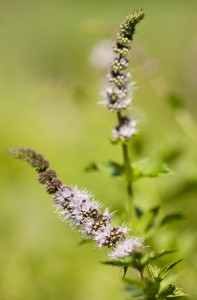
In Greek mythology, the goddess Persephone suspected her husband Hades, god of the underworld, of having a tryst with a nymph named Minthe. In a jealous rage, she transformed the lovely nymph into a perennial herb. Hades, unable to counteract his wife’s spell, bestowed Minthe with a sweet smell so that she would continue to delight those who came in contact with her.
Clearly, the aromatic qualities of mint are legendary. Through the centuries, mint has played an important role in many cultures, from the Greeks who rubbed mint leaves on their tables to welcome guests, to India, where it was strewn around temples and homes to clean the air. In the middle east, mint tea is often brought out to greet friends in the home.
Unlike many herbs that prefer sunny, dry spots, mints prefer moist soil in part shade/sun. As many of us know too well from experience, however, they are highly adaptable plants—and that’s putting it mildly. They grow in a wide range of conditions and are only too happy to expand their territory once they are planted in the ground. When I was a kid, my mother planted peppermint behind the vegetable garden; years later, the vegetable garden is gone, but the mint still thrives.
Posted in Photography on August 19 2014, by Matt Newman
While our yearly display of kiku—or Japanese chrysanthemums—presents some of the most elegant and delicate floral forms you’ll ever see, the process of raising them occasionally calls for some real muscle. Here, several of our Nolen Greenhouse staffers haul a protective tarp over a batch of young kiku in preparation for this fall’s exhibition.
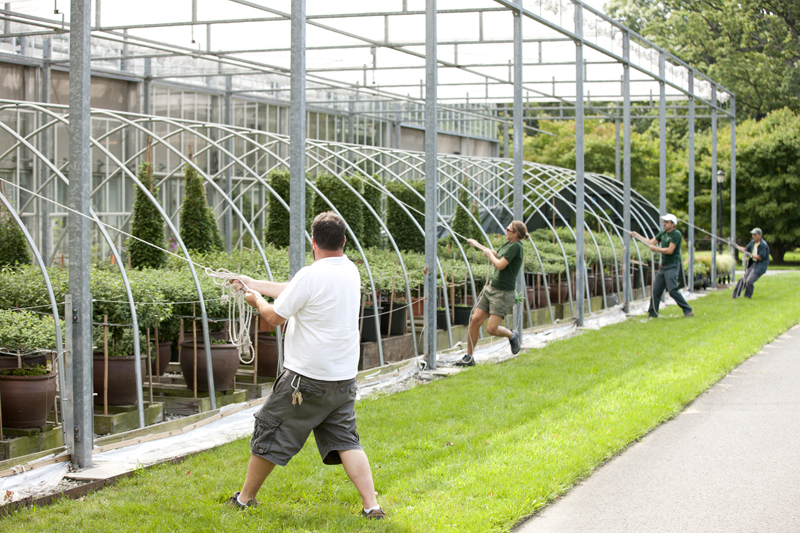
Posted in Photography on August 17 2014, by Lansing Moore
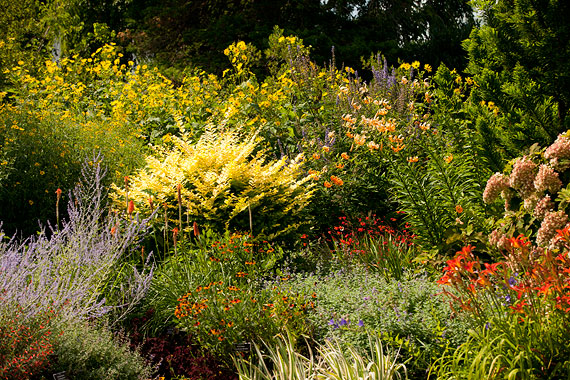
In the Perennial Garden – Photo by Ivo M. Vermeulen
Posted in Photography on August 16 2014, by Lansing Moore
If Hansel and Gretel didn’t have such a sweet tooth, I bet they’d enjoy the new Edible Archway. This appetizing structure is part of the new Curator’s Spotlight.
The Edible Archway at the Conservatory Courtyard – Photo by Ivo M. Vermeulen
Posted in Programs and Events on August 15 2014, by Lansing Moore
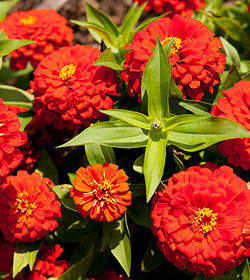 We are all very excited for a bright weekend after such a rainy week. Of course, the plants loved all that water—and it seems fitting that this weekend features two special tours of the Aquatic House! While the city is drying out, visit the wettest habitats in the Conservatory and admire the gorgeous plants within.
We are all very excited for a bright weekend after such a rainy week. Of course, the plants loved all that water—and it seems fitting that this weekend features two special tours of the Aquatic House! While the city is drying out, visit the wettest habitats in the Conservatory and admire the gorgeous plants within.
Don’t forget, next week is the last of our Jazz Age Evenings. On August 21 we bid farewell to these vintage-style soirées that brought such glamour and joy to Groundbreakers. Join us for the big bash as Michael Arenella & His Dreamland Orchestra transports guests back to the 40s with a swinging songbook inspired by the “Greatest Generation.” Our friends at Crabbie’s Alcoholic Ginger Beer will be serving up their own spicy twist on that classic summer cocktail—the Margarita.
Be sure to bring the kids this weekend for the Global Gardens Summer Harvest Celebration in the Ruth Rea Howell Family Garden! This weekend only, children will explore five Global Gardens and fill up their passports while enjoying activities. Click through for more details and the full program schedule.
Posted in Photography on August 15 2014, by Lansing Moore
The magnolia blossoms may have faded away with spring, but these trees remain beautiful fixtures on the Garden grounds all year long.
Magnolia stellata in the Ross Conifer Arboretum – Photo by Ivo M. Vermeulen
Posted in Horticulture on August 14 2014, by Don Gabel
Don Gabel is NYBG’s Director of Plant Health. He monitors, diagnoses, and prescribes treatments for all the plants growing on the grounds, as well as in NYBG’s beautiful gardens and glass houses. Don educates and provides horticultural advice to the staff as well as teaching the public about different aspects of horticulture. He lives in Rockland county New York.
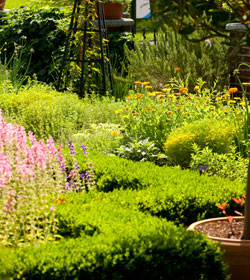 Here we go again! Just as we find a versatile, deer resistant, drought tolerant, easy-to-maintain landscape plant, a new pest problem emerges. Boxwood has been extensively planted over the last 20 years and I always say, “If you plant it they will come.” In late 2011, the pathogen causing boxwood blight (Cylindrocladium buxicola) was documented in the U.S. Since then it has been found in at least 5 states. This pathogen attacks the leaves and stems of boxwood, and a few related plants, eventually causing defoliation and death. The Northeast is full of mature specimen boxwood, and it is a popular landscape plant for new plantings, so there is a high potential for significant impact on landscape boxwood.
Here we go again! Just as we find a versatile, deer resistant, drought tolerant, easy-to-maintain landscape plant, a new pest problem emerges. Boxwood has been extensively planted over the last 20 years and I always say, “If you plant it they will come.” In late 2011, the pathogen causing boxwood blight (Cylindrocladium buxicola) was documented in the U.S. Since then it has been found in at least 5 states. This pathogen attacks the leaves and stems of boxwood, and a few related plants, eventually causing defoliation and death. The Northeast is full of mature specimen boxwood, and it is a popular landscape plant for new plantings, so there is a high potential for significant impact on landscape boxwood.
This disease began primarily as a nursery problem. Since then, it has spread to the landscape through new plantings of boxwood, and into the suburban landscape. When a single genus or species is over-planted in the landscape, eventually what were minor pests, or new invasive insects and diseases, can become major problems. The disease is now found in the landscape in western Connecticut as well as in Long Island and Westchester in New York. boxwood blight first appears as chocolate black spots on the foliage. In a few days the spots develop yellow to brown rings, eventually infecting the whole leaf. In a couple of weeks, the leaves die and fall off. The stem close to the infection can have black dead lesions or cankers.
Posted in Photography on August 14 2014, by Lansing Moore
Happy pollinators are the key to a successful garden!
In the Home Gardening Center – Photo by Ivo M. Vermeulen
Posted in Exhibitions, Gardens and Collections, Video on August 13 2014, by Lansing Moore
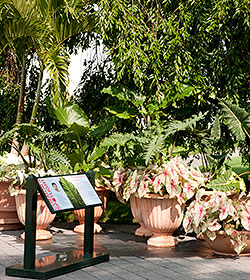 Visitors to the Garden will notice a number of small installations throughout the grounds as part of our new Curator’s Spotlight series. Behind the many gardens and collections that make up NYBG’s 250 acres is a legion of dedicated horticulturists and passionate curators, and for this new series we invited them to choose their own subject to focus on from the plant kingdom.
Visitors to the Garden will notice a number of small installations throughout the grounds as part of our new Curator’s Spotlight series. Behind the many gardens and collections that make up NYBG’s 250 acres is a legion of dedicated horticulturists and passionate curators, and for this new series we invited them to choose their own subject to focus on from the plant kingdom.
There is so much to see in the vast diversity of the Garden. Who better to guide our visitors and direct their attention to some of the individual beauty on display than the people who cultivate it? See the Garden through the eyes of its experts in this new video for Curator’s Spotlight, in which Kevin Character overviews some of the fun new installations our curators have dreamed up. Hear from our own Christian Primeau, Manager of the Enid A. Haupt Conservatory, on why he chose to highlight the whimsical colocasia, also known as elephant’s ear.
More videos are coming soon! In the meantime, keep an eye out for Curator’s Spotlight installations on your next visit. See the full lineup here.